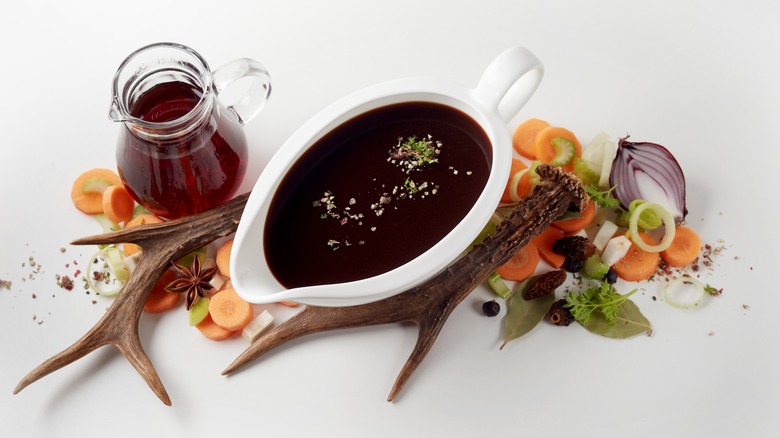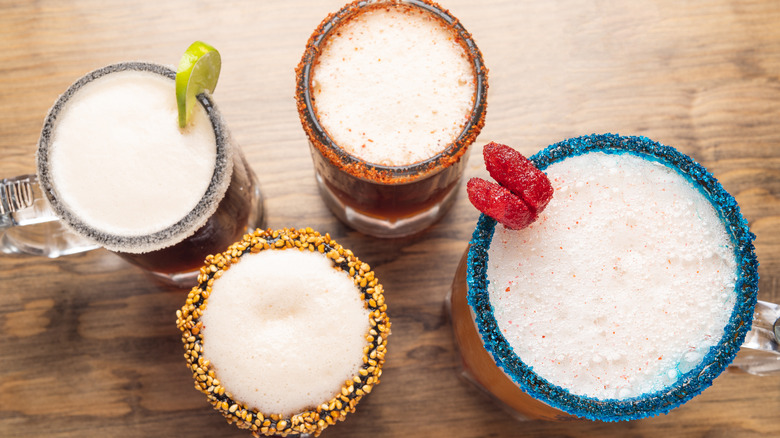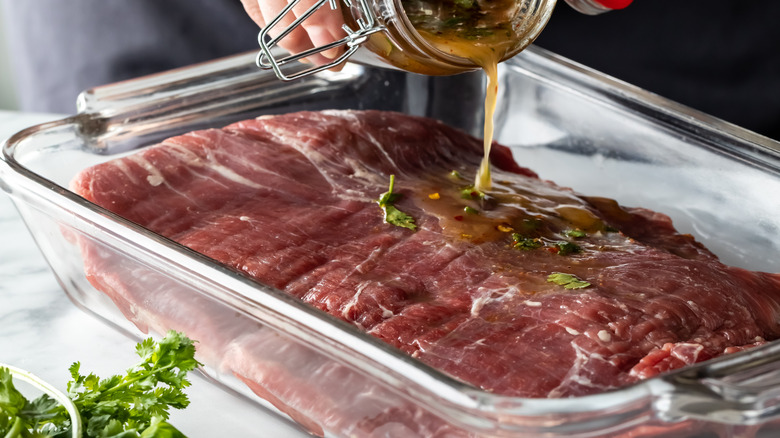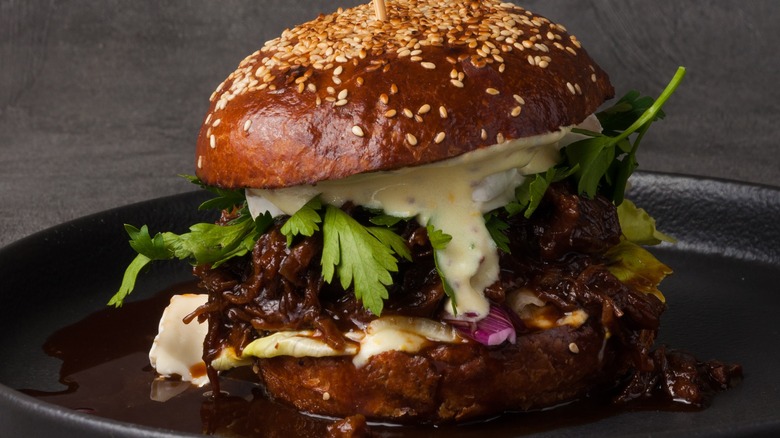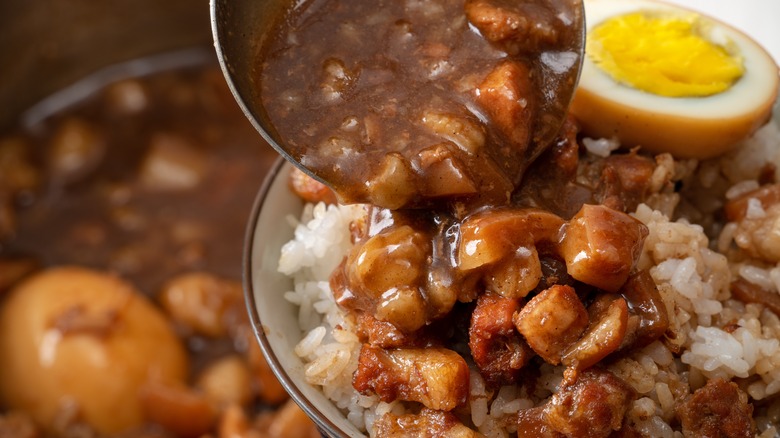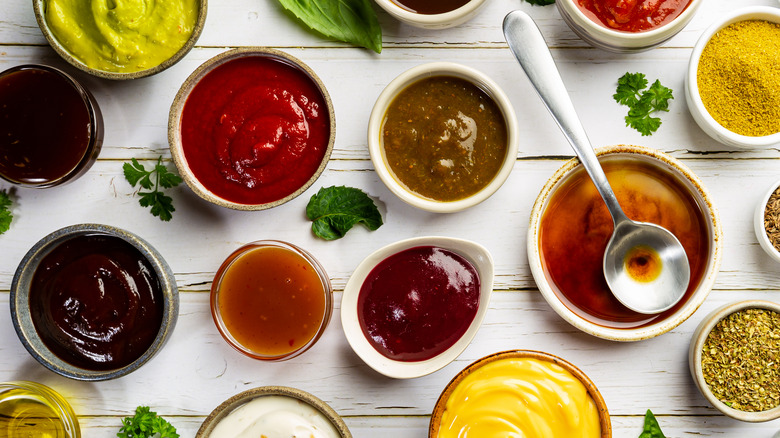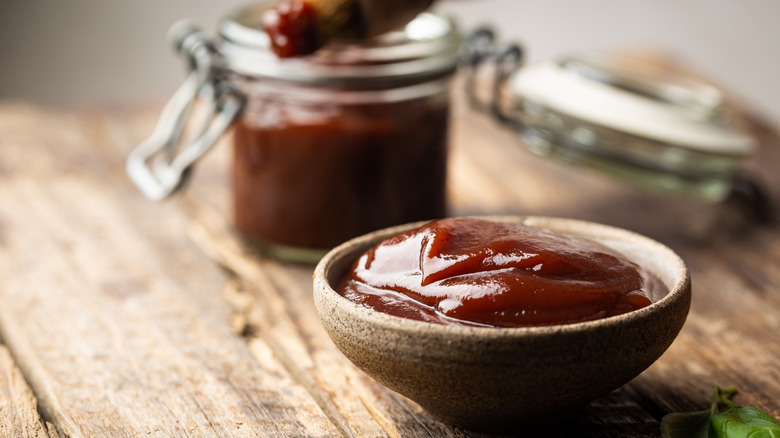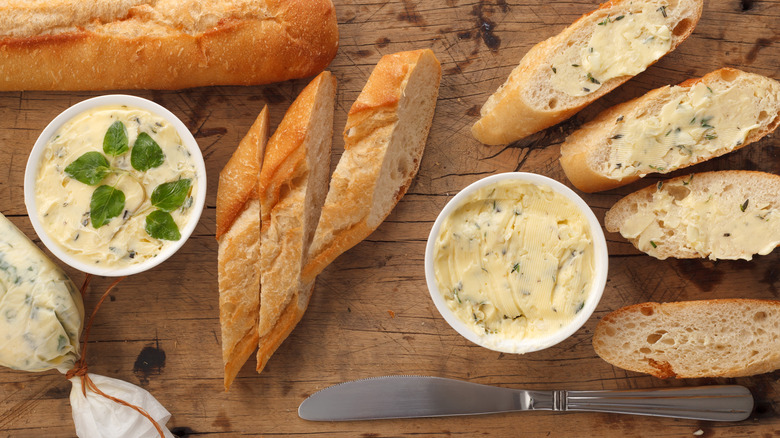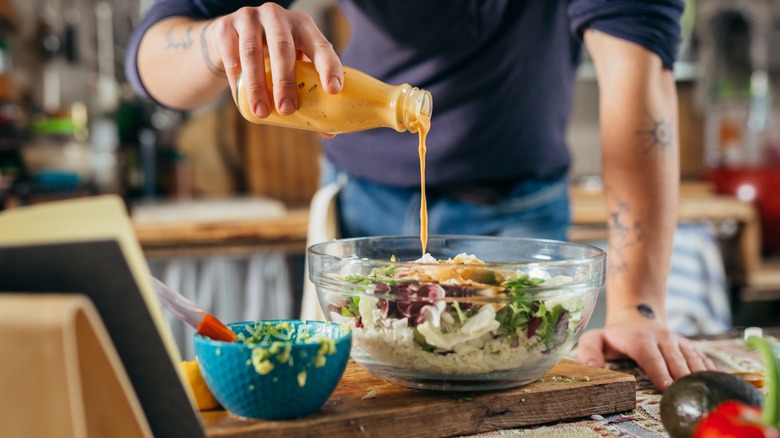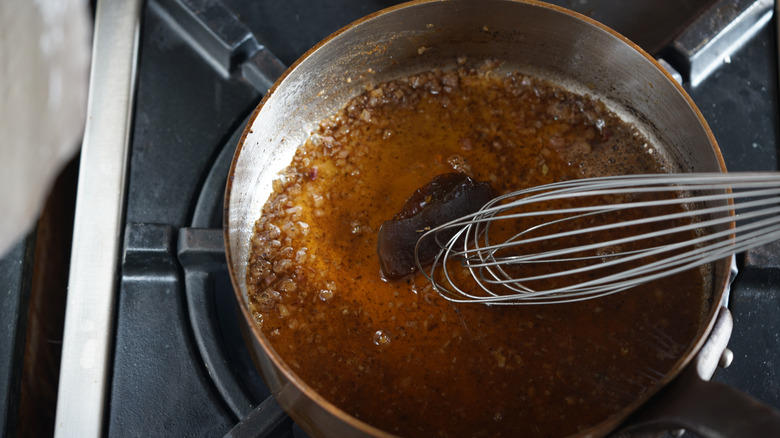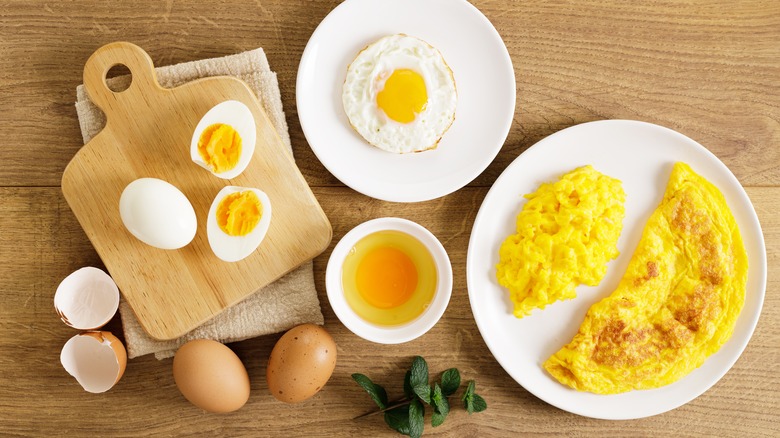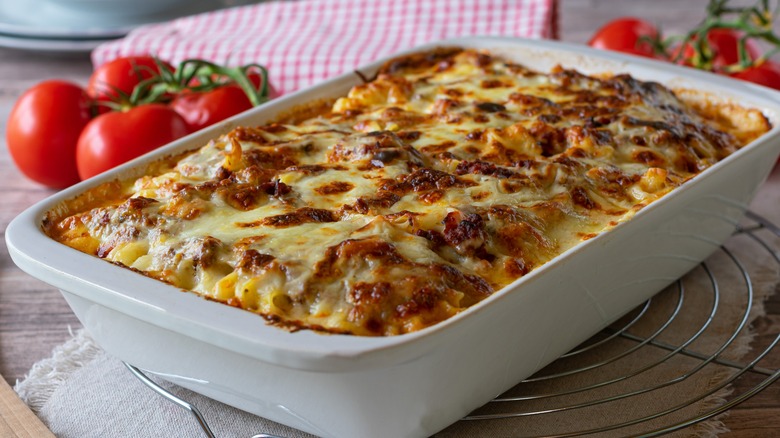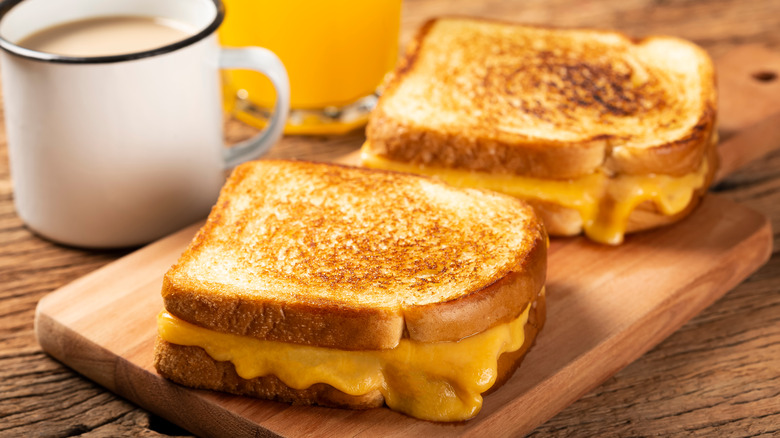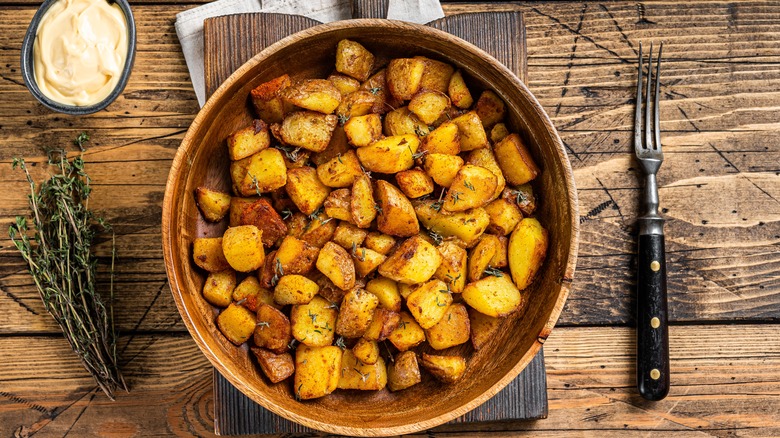13 Unconventional Ways To Use Worcestershire Sauce
Worcestershire sauce is one of those secret flavor bomb ingredients that you can add to just about any dish for a little extra zing. It's salty, tangy, savory, and a little sweet, and with just a few drops of it can transform something bland into something delectable. If you have a bottle in your kitchen, you may be wondering what exactly you should do with it. You might also be wondering how to say it.
According to Merriam-Webster, spelled out phonetically it's wu̇-stər-ˌshir-, which sounds like wuss-ter-sheer. It's named after the city of Worcester, England, where the sauce was first crafted by two men named John Lea and William Perrins in the 19th century, according to Worcester News.
Vinegar and molasses are the main ingredients in Worcestershire sauce, along with salt and sugar. Its unique flavor is created from a mix of onions, garlic, anchovies, tamarind, and spices. Fermentation is what gives the sauce its special character, and legend has it that the original sauce tasted awful, so Lea and Perrins left casks of it in a basement and forgot about them, only to find them years later full of sauce that had fermented to delicious perfection. However it came to be, Worcestershire sauce is a must-have item for any cook. Here are some exciting ways you can utilize this classic sauce in your culinary adventures.
1. Create savory cocktails and mocktails
Worcestershire sauce is an essential ingredient in the classic brunch cocktail, the Bloody Mary. But its suitability for beverages doesn't stop there. Any drink, whether it's a cocktail or a non-alcoholic beverage, that can handle a bit of savoriness can benefit from a few dashes of Worcestershire sauce to kick up its flavors.
The Michelada is another popular daytime drink that includes Worcestershire sauce. Similar to its cousin, the Bloody Mary, it swaps out vodka for Mexican beer, although some versions omit the tomato juice. The Bullshot is an interesting cocktail that's basically vodka-spiked beef broth served hot, along with lemon juice, hot sauce, and, of course, a little bit of Worcestershire. The savory, tangy flavors in Worcestershire match up well with the peppery, vegetal notes in tequila and mezcal, so why not add a few dashes to your next margarita?
For a booze-less beverage, a little bit of Worcestershire thrown together with tomato juice is a tangy, refreshing combo, without the need for any hard liquor. Additionally, you can add some to a vegetable-based smoothie for an instant flavor boost.
2. Add flavor to marinades and brines
Worcestershire sauce is a great addition to any marinade or brine mixture, because of its ability to bring a combination of salty, sweet, and umami, which is all the flavor bases covered in one ingredient. Whether you're submerging a whole turkey, tenderizing a tough cut of steak, or infusing flavor into a block of tofu, a little bit of Worcestershire sauce goes a long way, giving your marinade depth and complexity with just a spoonful or two.
The flavor profile of Worcestershire sauce is versatile enough to complement any meat. Try it in this sweet, summery chicken wing marinade. It's perfect with steak, too, helping boost its meaty flavor, whether you're cooking the beef sous vide or using more traditional methods. You can even use it when marinating fish and shellfish -– it's great with shrimp, as it's an ingredient in classic shrimp cocktail sauce.
One thing to keep in mind when adding Worcestershire sauce to your marinade or brine is the salt content. Since Worcestershire is naturally salty, you won't need to add as much actual salt to the liquid to achieve the same seasoning level, so be sure to adjust accordingly.
3. Mix into burgers, meatloafs, and meatballs
The savory quality of Worcestershire sauce is a delicious complement to beef, and its tanginess works as a contrast to the meat's richness. That's why a splash or two of Worcestershire sauce can amplify the flavors of beef-based dishes so well, and why you should be adding it to all of your burger, meatball, and meatloaf recipes.
A spoonful or two is easily incorporated into any ground meat mixture, no matter what form it's going to take. Worcestershire sauce can be used in combination with other seasonings or alone, since it has such a deep and complex flavor. A classic meatloaf wouldn't taste the same without it, and it brings a gourmet flair to even the most humble burgers or meatballs. While Worcestershire is a match made in heaven with beef, it complements other meats like pork, too, which is why it's an essential ingredient in our bacon-studded "Best Burger Ever" recipe. Once you try a Worcestershire-spiked burger, you'll wonder how you ever enjoyed a burger without it.
4. Liven up soups, stews, and chilis
There are few things as satisfying as a pot of food simmering for hours, filling the kitchen with comforting aromas. A slow-cooked stew or soup usually results in deeply concentrated flavors, but if you find they're not quite enough, adding some Worcestershire sauce to the pot is a great way to achieve that level of depth and intensity.
Because of its versatility, Worcestershire sauce can be a valuable addition to just about any one-pot dish. A big batch of chili, whether it's meat or bean-based, can benefit from the hit of umami and tang that Worcestershire brings. Its savory-sweet flavor combination is perfect in classic French onion soup, boosting the beef broth flavor and intensifying the sweetness of the caramelized onions. And any hearty long braise, especially beef stew, can be improved with a little swig of Worcestershire sauce. Just be sure, especially if you're adding it at the beginning before any liquid has reduced, that you're careful when adding more salt, or it could become overseasoned.
5. Amp up condiments and dips
While Worcestershire sauce can be used on its own, drizzled on as a sauce, or served on the side as a dip, it can be a little intense. It works even better when mixed together with other dips, sauces, and condiments to complement and contrast with their flavors. Dipping sauces, sandwich spreads, relishes, you name it -– pretty much anything in these categories can benefit from a bit of Worcestershire flair.
A splash of Worcestershire stirred into mayo or aioli elevates the simple condiment, helping add both depth and dimension. It's a natural complement to ketchup, as it shares many of the same ingredients and flavors, like sugar and vinegar. Cook Joshua Weissman uses it in his version of In-N-Out's burger sauce, which uses both ketchup and mayo, along with pickle, chives, and caramelized onions. It brings extra tang to tartar sauce, too.
Just about any dip recipe can be improved with Worcestershire sauce, though. It's a classic ingredient in crab dip, brings some zip to cheese dip, and can add an extra pop of flavor to store bought dips like onion and ranch. While not necessarily a classic ingredient in pimento cheese, a spoonful of Worcestershire sauce mixed into the classic Southern dish makes its flavors come together beautifully.
6. Add zest to barbecue sauce
Whether you use the store bought stuff, or are a grill aficionado who makes their own barbecue sauce from scratch, every barbecue fan can benefit from adding Worcestershire sauce into the mix. Its affinity for meat makes it a particularly apt ingredient for barbecue, and its combination of sweet, salty, savory, and zesty flavors will upgrade any sauce, no matter which style of BBQ you're cooking.
Worcestershire sauce is the perfect ingredient in sweet, molasses and tomato-based barbecue sauces, such as the kind you'll find in Kansas City, Memphis, and parts of Texas, as its similar character helps to amplify the sauce's flavors. South Carolina's tangy, mustardy sauce is an excellent match for Worcestershire, too, as are its neighbor to the north's vinegar-heavy barbecue sauces. Kentucky barbecue in particular is known for its love of Worcestershire, with a classic sauce that claims it as a main ingredient, traditionally served with mutton. Whatever style of sauce you use, and whether you're slathering it on ribs, brisket, or wings, don't forget to add the Worcestershire for ultimate flavor.
7. Bring umami to compound butter
Compound butter is one of the easiest ways to add more flavor to your food. Take softened butter, mix in one or more other flavorful ingredients, then shape and refrigerate it. The end result is an instant flavor-boosting substance at the ready. It can be spread on bread, melted on top of meats and vegetables, used as a base for sauces, and countless other possibilities. Worcestershire sauce, with its intense wallop of flavor, is a fantastic addition to compound butter, either by itself or in combination with other ingredients.
One classic compound butter is known as maitre d'hotel, which includes lemon juice and parsley. Add Worcestershire sauce to this recipe for a deeper, more savory flavor. Garlic, shallots, and Worcestershire sauce make another great combination, along with salt and black pepper to taste. This combination is particularly good when used to top steaks. Fresh herbs, chilis, ground spices, flavored oils, and really anything else in your kitchen can be added to compound butter, along with Worcestershire sauce, to create any flavor combination you can imagine. Compound butter can be refrigerated or frozen and used whenever you need a big flavor boost with minimal effort.
8. Add dimension to salad dressings
The original Caesar salad dressing recipe, created at Caesar's in Tijuana, Mexico, is a carefully crafted concoction that's made tableside, according to BBC Travel. Garlic is mixed with mustard, anchovies, and Worcestershire sauce before egg, citrus juice, oil, and cheese are stirred in to create the emulsion. This magical combination of flavors and texture has endured for decades, and certainly the intense flavor of Worcestershire sauce is crucial to its success. Without it, Caesar dressing would lack some of its savory, umami character.
It's not just Caesar dressing that can benefit from Worcestershire's intensity. Any salad dressing can use its kick, from creamy homemade ranch dressing to a simple vinaigrette. The tang from Worcestershire enhances and balances the rich and pungent flavor of blue cheese dressing. Ketchup and mayo-based dressings like Thousand Island and French often have Worcestershire sauce added. A few dashes added to fresh, bright herb dressings like Green Goddess and Italian will add another dimension of deeper, more savory flavor. Even a sweeter dressing, like honey mustard vinaigrette, can be elevated and balanced by a little Worcestershire sauce.
9. Create a savory pan sauce
The secret to making a delicious pan sauce is a technique called deglazing. Essentially, according to BBC GoodFood, it's the process of adding a liquid to your pan and then stirring up the fond that's adhered to the bottom surface. The hot liquid helps to release this flavor-packed substance to create a rich, concentrated sauce that echoes the flavors of the meat or other ingredients you just sautéed in the pan. Any liquid can be used to deglaze a pan, though wine and stock are most commonly used, while water can be used in a pinch. Even spirits like brandy and whiskey can be used, although they need to be added carefully off the heat to prevent out of control flames from forming. If you want to create a truly flavorful, intense pan sauce, deglaze with Worcestershire sauce.
You can use Worcestershire sauce to deglaze on its own, or mixed with other liquid ingredients if you want a more subtle Worcestershire flavor. The flavorful remnants of whatever meat or vegetables you cooked in the pan will combine with the Worcestershire, which will enhance and amplify the savory notes, while adding zest and tang to balance the sauce. Even just a small splash of Worcestershire in your pan will ensure that you'll have the most flavorful pan sauce possible.
10. Jazz up egg dishes
Eggs are an incredibly versatile food, and Worcestershire sauce is just as versatile a condiment, so it just makes sense that these two ingredients would pair perfectly together. Instead of hot sauce, the next time you make scrambled eggs, try dashing on a few drops of Worcestershire sauce. The savory layers of flavor beautifully complement the fluffy, creamy eggs for a decadent breakfast. You can also add the Worcestershire in while you're mixing your eggs to distribute the flavor evenly, and the same goes for omelets and frittatas.
Other types of egg dishes are also prime candidates for a burst of Worcestershire flavor. Add it to egg salad and deviled egg filling to create more depth and dimension. Any recipe that combines eggs and meat, like steak and eggs, or corned beef hash, is particularly well suited for the addition of Worcestershire, as it's the perfect complement to beef. A dash of Worcestershire sauce will punch up the flavor of Hollandaise sauce, creating the most delectable eggs Benedict. And a few drops drizzled over a simple fried egg will give that humble breakfast food a little extra pizazz.
11. Enhance casseroles, lasagnas, and mac & cheese
Italian food purists may shake their heads, but a little bit of Worcestershire sauce added to lasagna can make its flavors truly shine. A few dashes combined with the meat and tomato layer of a classic lasagna Bolognese adds intensity and complexity, complementing the other ingredients without necessarily overwhelming them.
Other baked and layered dishes can also be improved by adding in a few touches of Worcestershire sauce. Try it in an old school tuna noodle casserole – the hit of umami enhances the tuna's flavor. Additionally, any dish with lots of creamy richness can use a bit of Worcestershire sauce's tangy acidity to help balance out its texture, which is why it's a great ingredient to add to macaroni and cheese. The same goes for any other cheesy, saucy bakes, such as potatoes gratin. It's important to note that without balance, these dishes can be overly heavy, and Worcestershire sauce can fix that by cutting through the fat, while also adding its own unique flavors.
12. Boost the flavor of grilled cheese
One of the most famous recipes that involves Worcestershire sauce is rarebit. This dish, originating from the United Kingdom, has several variations depending on what part of the UK it's from, but it's basically toasted bread covered in a cheese sauce that includes Worcestershire and other ingredients, including spices, and sometimes wine or beer, according to Britannica. Since Worcestershire sauce works so well as an ingredient in this dish, it only makes sense that it should be added to other cheese and bread recipes, too.
You can add Worcestershire sauce to your grilled cheese sandwich in a few different ways. If you're spreading a condiment such as mayo or mustard on the inside of your bread, swirl a few drops of Worcestershire into it first. Instead of layering cheese slices, you can grate your cheese and mix some Worcestershire sauce into the cheese mixture before you add it to your bread. If you're using mayo or butter on the outside of your sandwich, you can add some Worcestershire sauce to that, too. Go for all three methods if you want to create the most maximum umami-laden grilled cheese sandwich possible.We promise it won't disappoint.
13. Upgrade your classic potato dishes
Worcestershire sauce is an essential ingredient in shepherd's pie, a classic British comfort dish. The condiment is typically added to the meat and vegetable mixture that makes up the base, which is then covered with a layer of mashed potatoes and baked. While the Worcestershire's main job is to intensify and enhance the meat's savory flavor, it also perfectly complements the creamy mashed potato topping, adding just enough zing to cut through the richness. The next time you make mashed potatoes on their own, go ahead — add a few dashes of Worcestershire sauce for some extra zip.
It's not just for mashed potatoes, either. Consider adding Worcestershire sauce to any potato dish, from soups to casseroles. Toss cut potatoes in a mixture of oil and Worcestershire sauce before roasting to infuse them with flavor. You can also add Worcestershire sauce to any toppings that you're loading onto your baked potatoes. Finally, Worcestershire sauce is a delicious way to punch up potato salad dressing.
